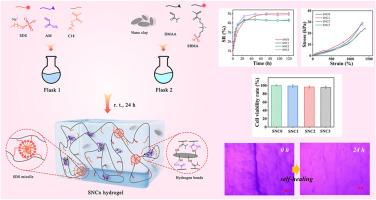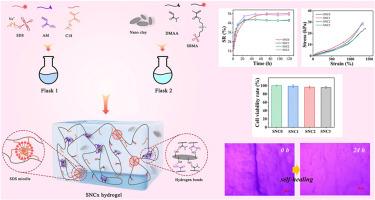Highly stretchable, self-healing, and biocompatible betaine-based hydrogels with high water absorption and mechanical resilience
IF 4.5
2区 化学
Q2 POLYMER SCIENCE
引用次数: 0
Abstract
Double-physically crosslinked hydrogels are well-known for their exceptional self-healing and mechanical properties but often fall short in terms of biological functionality. Here, we introduce a novel betaine-based zwitterionic hydrogel designed to simultaneously enhance self-healing, mechanical strength, and biocompatibility. The hydrogel is synthesized via thermally initiated free-radical polymerization and utilizes dual physical crosslinking through hydrophobic monomer-based micelles and nanoscale Laponite XLG. The incorporation of betaine monomers further boosts the biological performance of the material. The resulting hydrogel exhibits excellent swelling behavior, achieving equilibrium within 48 h, with a water absorption capacity up to 5000 % and an equilibrium water content exceeding 98 %. Mechanically, the hydrogel exhibits a remarkable elongation at break of 1228 % under tensile testing. Furthermore, it shows exceptional self-healing properties, with fracture elongation recovery of 542.72 % after 2 h and 746.88 % after 24 h. Microscopic observations confirm near-complete healing within just 3 min. Cell viability assays reveal over 95 % cell survival in the presence of hydrogel extracts, confirming its excellent biocompatibility, high water retention, and mechanical resilience.


高度可拉伸,自我修复和生物相容性甜菜碱基水凝胶具有高吸水性和机械弹性
双物理交联水凝胶以其卓越的自我修复和机械性能而闻名,但在生物功能方面往往不足。在这里,我们介绍了一种新型甜菜碱两性离子水凝胶,旨在同时增强自愈,机械强度和生物相容性。该水凝胶通过热引发自由基聚合合成,并通过疏水单体胶束和纳米级拉脱石XLG进行双重物理交联。甜菜碱单体的掺入进一步提高了材料的生物性能。所得水凝胶具有优异的膨胀性能,可在48小时内达到平衡,吸水率高达5000%,平衡含水量超过98%。力学性能方面,水凝胶的断裂伸长率在宏观上达到900%,在拉伸试验中达到1250%。此外,它还表现出优异的自愈性能,2 h后断裂伸长率恢复542.72%,24 h后断裂伸长率恢复746.88%。显微镜观察证实在3分钟内几乎完全愈合。细胞活力分析显示,在水凝胶提取物存在下,超过95%的细胞存活率,证实了其良好的生物相容性,高保水性和机械弹性。
本文章由计算机程序翻译,如有差异,请以英文原文为准。
求助全文
约1分钟内获得全文
求助全文
来源期刊

Polymer
化学-高分子科学
CiteScore
7.90
自引率
8.70%
发文量
959
审稿时长
32 days
期刊介绍:
Polymer is an interdisciplinary journal dedicated to publishing innovative and significant advances in Polymer Physics, Chemistry and Technology. We welcome submissions on polymer hybrids, nanocomposites, characterisation and self-assembly. Polymer also publishes work on the technological application of polymers in energy and optoelectronics.
The main scope is covered but not limited to the following core areas:
Polymer Materials
Nanocomposites and hybrid nanomaterials
Polymer blends, films, fibres, networks and porous materials
Physical Characterization
Characterisation, modelling and simulation* of molecular and materials properties in bulk, solution, and thin films
Polymer Engineering
Advanced multiscale processing methods
Polymer Synthesis, Modification and Self-assembly
Including designer polymer architectures, mechanisms and kinetics, and supramolecular polymerization
Technological Applications
Polymers for energy generation and storage
Polymer membranes for separation technology
Polymers for opto- and microelectronics.
 求助内容:
求助内容: 应助结果提醒方式:
应助结果提醒方式:


